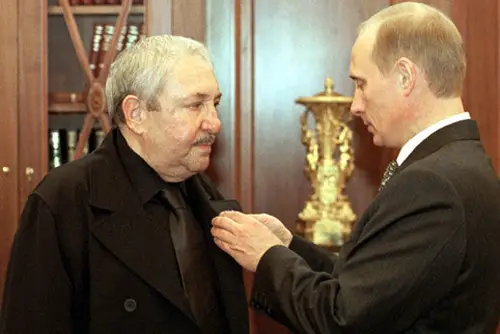Ernst Neizvestny
(1926– 2016)

Neizvestny receives Order of Honor from Vladimir Putin
Ernst Neizvestny was a Russian sculptor and draughtsman. Neizvestny was one of the few living Russian artists whose work became known and admired in the West. This was largely the result of the admiration and advocacy of the English art critic John Berger, in whose opinion "Neizvestny is principally the first visual artist of genius to have emerged in the Soviet Union since the twenties."
Neizvestny was born on April 9, 1925, in Sverdlovsk.
During his teens, he went to the Sverdlovsk School № 16. There, he was on friendly terms with another student named Vladimir Vinnichevsky, who later on became a serial killer.
In 1942, at the age of 17, he joined the Red Army as a volunteer. At the close of World War II, he was severely wounded. Although he was awarded the Order of the Red Star "posthumously" and his mother received an official notification that her son had died, Neizvestny managed to survive.
In 1947, Neizvestny was enrolled at the Art Academy of Latvia in Riga. He continued his education at the Surikov Moscow Art Institute and the Philosophy Department of the Moscow State University. His sculptures, often based on the forms of the human body, are noted for their expressionism and powerful plasticity. Although his preferred material is bronze, his larger, monumental installations are often executed in concrete. Most of his works are arranged in extensive cycles, the best known of which is The Tree of Life, a theme he has developed since 1956.
He came into prominence during the regime of Nikita Khrushchev. On a famous occasion Neizvestny argued with the Russian leader at the opening of an exhibition of advanced art he had organized in Moscow. Neizvestny's art is best when dealing with the human figure. He cast his bronzes personally in a small furnace,
Neizvestny later immigrated to the United States after leaving the Soviet Union for Switzerland in 1976. During the 1980s, Neizvestny was a visiting lecturer at the University of Oregon and at UfC Berkeley.
Neizvestny's talent for large monumental sculptures was again recognized when in the late 1980s six Taiwan cities commissioned the New Statue of Liberty to be built in Kaohsiung harbor. Like the original in New York, it was planned to be 152 feet tall. Several models were built. At least one about five feet tall, and approximately 13 smaller bronzes, each slightly over 18 inches, sold to clients of Magna Gallery in San Francisco. Although the authorized maximum number of signed and numbered castings was 200, far fewer were actually cast and sold, in part because the monument was never built in Taiwan. He held exhibitions in many countries including Scandinavia, Italy, and Switzerland.
His essays on art, literature, and philosophy, collected in Space, Time and Synthesis in Art, appeared in English in 1990. After the breakup of the Soviet Union he was commissioned to erect three Gulag memorials.
In 1996, Neizvestny completed his Mask of Sorrow, a 15-metre (49 ft) tall monument to the victims of Soviet purges, situated in Magadan.[4] The same year, he was awarded the State Prize of the Russian Federation. Although he lived in New York City and worked at Columbia University, Neizvestny frequently visited Moscow and celebrated his 80th birthday there. A museum dedicated to his sculptures was established in Uttersberg, Sweden. Some of his crucifixion statues were acquired by John Paul II for the Vatican Museums.
In 2004, Neizvestny became an honorary member of the Russian Academy of Arts
ADD. BIBLIOGRAPHY
E. England, Ernest Neizvestny, Life and Work (1984); A. Leong, The Life and Art of Ernst Neizvestny (2002).
Sources: Encyclopaedia Judaica. © 2007 The Gale Group. All Rights Reserved.
Ernst Neizvestny,
Wikipedia.
Photo: Kremlin.ru, CC BY 3.0 via Wikimedia Commons.


